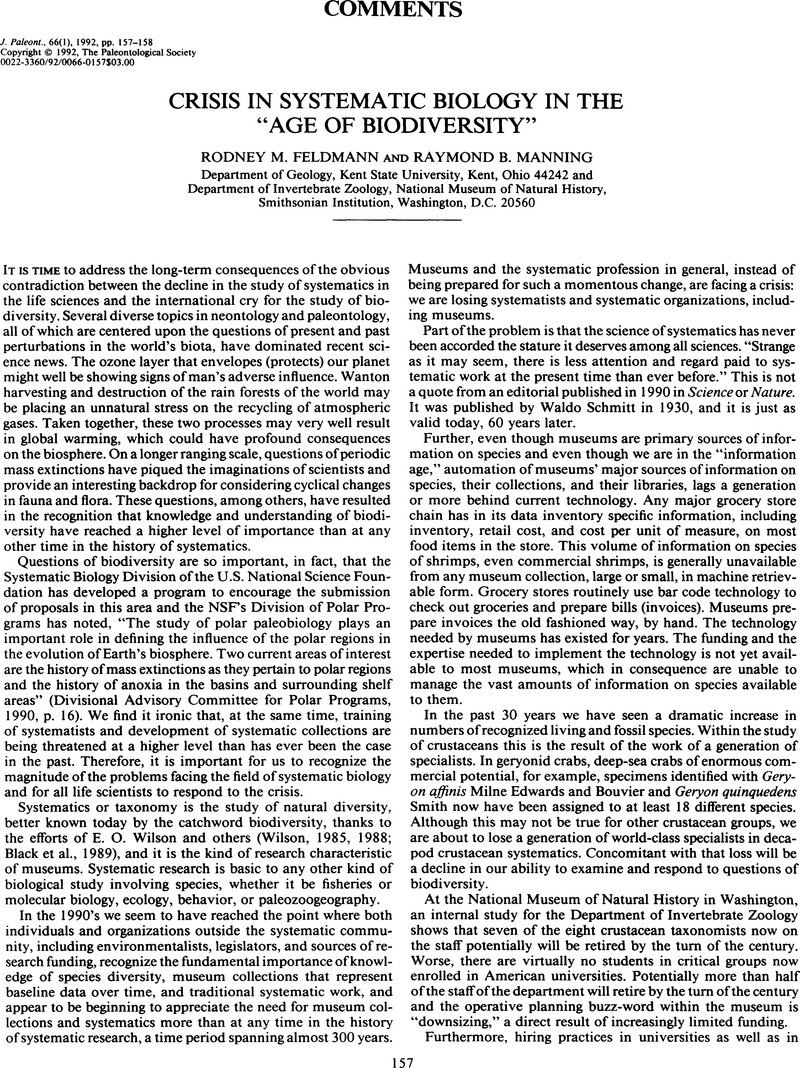Crossref Citations
This article has been cited by the following publications. This list is generated based on data provided by Crossref.
Sullivan, Robert M.
Deméré, Thomas A.
and
Pregill, Gregory K.
1992.
Paleontology at the San Diego Natural History Museum: a reply to Comment by Feldmann and Manning.
Journal of Paleontology,
Vol. 66,
Issue. 3,
p.
532.
Butman, Cheryl Ann
and
Carlton, James T.
1995.
Marine biological diversity: Some important issues, opportunities and critical research needs.
Reviews of Geophysics,
Vol. 33,
Issue. S2,
p.
1201.
Wardle, D.A.
1995.
Advances in Ecological Research Volume 26.
Vol. 26,
Issue. ,
p.
105.
Maurer, Don
2000.
The Dark Side of Taxonomic Sufficiency (TS).
Marine Pollution Bulletin,
Vol. 40,
Issue. 2,
p.
98.
Reaka-Kudla, Marjorie L.
2001.
Encyclopedia of Biodiversity.
p.
915.
ADRAIN, JONATHAN M.
2001.
SYSTEMATIC PALEONTOLOGY.
Journal of Paleontology,
Vol. 75,
Issue. 6,
p.
1055.
Reaka-Kudla, Marjorie L.
2001.
Waters in Peril.
p.
19.
Reaka-Kudla, Marjorie L.
2001.
Encyclopedia of Biodiversity.
p.
396.
ADRAIN, JONATHAN M.
2001.
SYSTEMATIC PALEONTOLOGY.
Journal of Paleontology,
Vol. 75,
Issue. 6,
p.
1055.
Gill, Anthony C.
and
Kemp, Jeremy M.
2002.
Widespread Indo-Pacific Shore-fish Species: A Challenge for Taxonomists, Biogeographers, Ecologists, and Fishery and Conservation Managers.
Environmental Biology of Fishes,
Vol. 65,
Issue. 2,
p.
165.
Adrain, Jonathan M.
and
Westrop, Stephen R.
2003.
Paleobiodiversity: we need new data.
Paleobiology,
Vol. 29,
Issue. 1,
p.
22.
Terlizzi, A
Bevilacqua, S
Fraschetti, S
and
Boero, F
2003.
Taxonomic sufficiency and the increasing insufficiency of taxonomic expertise.
Marine Pollution Bulletin,
Vol. 46,
Issue. 5,
p.
556.
Sumrall, Colin D.
and
Brochu, Christopher A.
2008.
Viewing Paleobiology Through the Lens of Phylogeny.
The Paleontological Society Papers,
Vol. 14,
Issue. ,
p.
165.
Villac, Maria Célia
and
Tenenbaum, Denise Rivera
2010.
The phytoplankton of Guanabara Bay, Brazil: I. historical account of its biodiversity.
Biota Neotropica,
Vol. 10,
Issue. 2,
p.
271.
Ahrends, Antje
Rahbek, Carsten
Bulling, Mark T.
Burgess, Neil D.
Platts, Philip J.
Lovett, Jon C.
Kindemba, Victoria Wilkins
Owen, Nisha
Sallu, Albert Ntemi
Marshall, Andrew R.
Mhoro, Boniface E.
Fanning, Eibleis
and
Marchant, Rob
2011.
Conservation and the botanist effect.
Biological Conservation,
Vol. 144,
Issue. 1,
p.
131.
Allmon, Warren D.
2011.
Natural History of Turritelline Gastropods (Cerithiodea: Turritellidae): A Status Report.
Malacologia,
Vol. 54,
Issue. 1-2,
p.
159.
Maskour, Lhoussaine
El Batri, Bouchta
Ksiksou, Jamal
Jeronen, Eila
Agorram, Boujemaa
Alami, Anouar
and
Bouali, Rahma
2022.
Views of Moroccan University Teachers on Plant Taxonomy and Its Teaching and Learning Challenges.
Education Sciences,
Vol. 12,
Issue. 11,
p.
799.
Favret, Colin
2024.
The 5 ‘D’s of Taxonomy: A User’s Guide.
The Quarterly Review of Biology,
Vol. 99,
Issue. 3,
p.
131.



